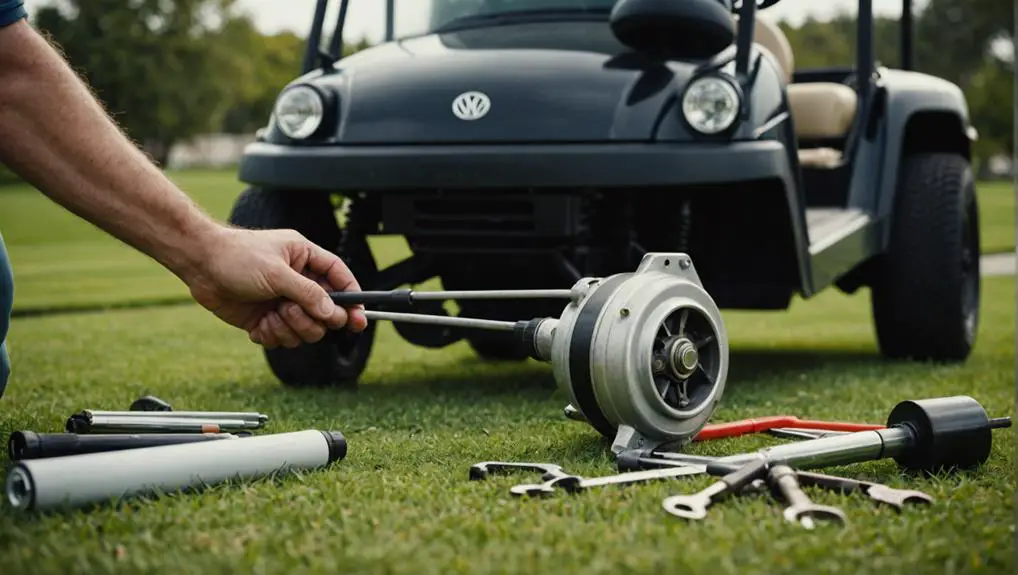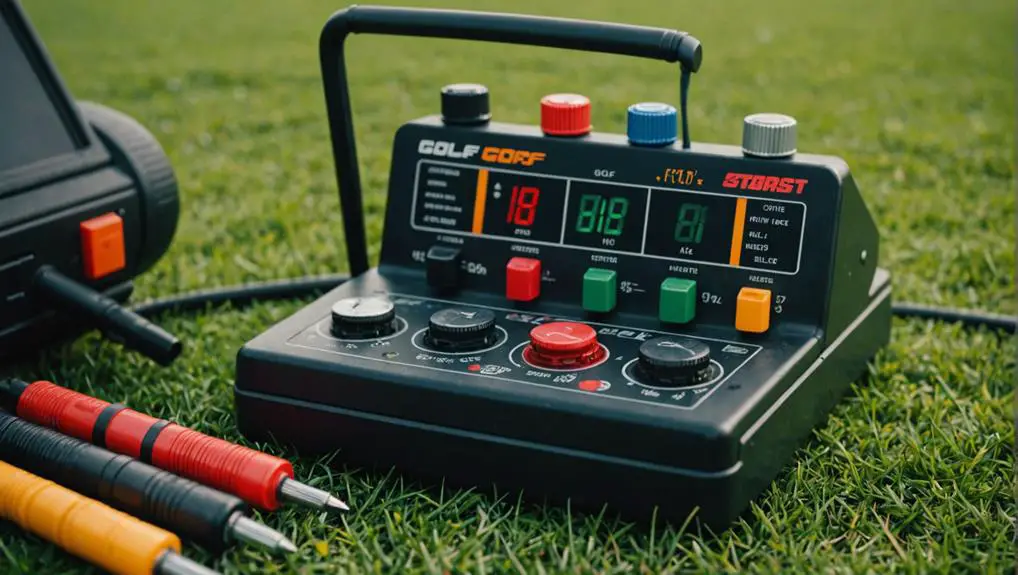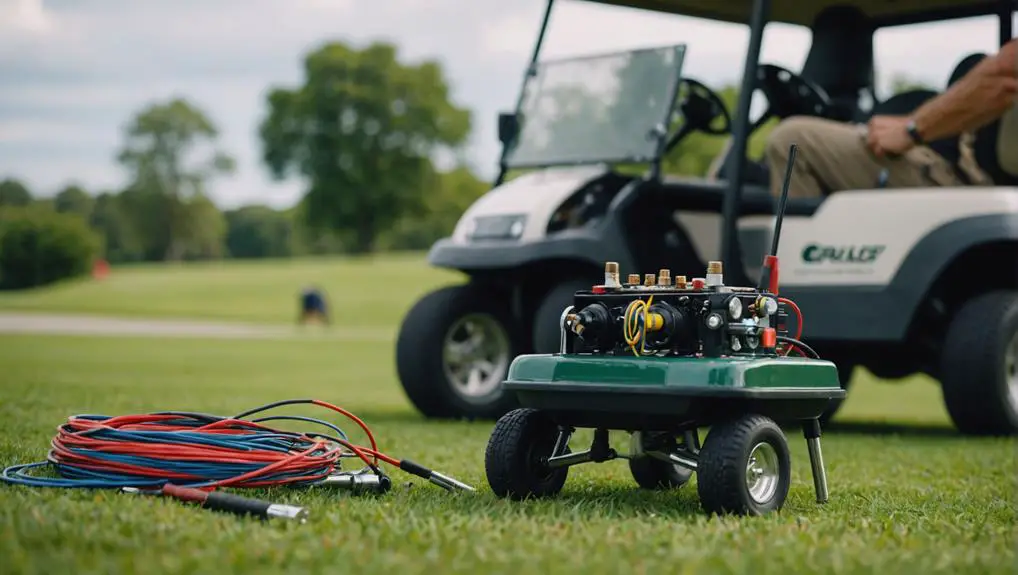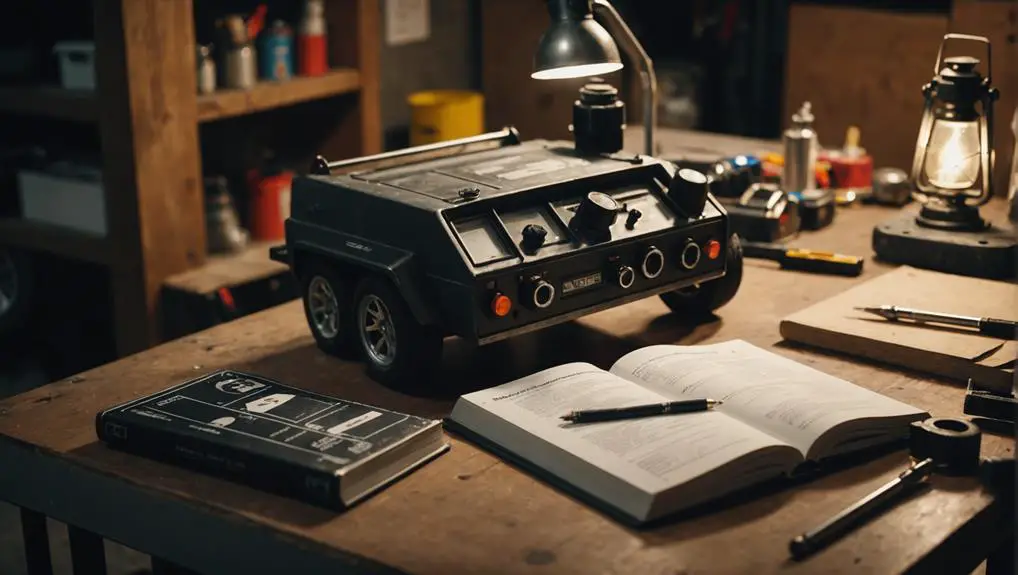When your gas golf cart won't turn over, it can be frustrating, but there are several areas you can check to identify the issue. Start by examining the battery connections and charge level, as these are often the culprits behind a no-start situation. Next, consider the ignition and safety switches, which play essential roles in the starting process. However, these steps are just the beginning—let's explore some deeper troubleshooting techniques that could uncover more hidden problems.
Key Takeaways
- Verify the battery charge; a healthy battery should read around 12.6 volts or higher, and ensure terminals are clean and tight.
- Inspect wiring connections for corrosion or looseness; damaged wires can interrupt starting signals and prevent the cart from turning over.
- Check the ignition switch and safety switches; ensure they are functioning properly and are in the correct position for starting.
- Examine the starter motor and solenoid for loose connections or corrosion; test voltage to ensure proper power supply to the starter.
- Review fuses for blown filaments; replace any faulty fuses with the same amperage rating to restore electrical flow.
Check the Battery Charge
Before you rush to diagnose other issues with your gas golf cart, the first step is to check the battery charge. A low or dead battery can prevent the cart from turning over, so it's crucial to verify it's in good condition.
Begin by locating the battery compartment, usually found under the seat or rear panel. Inspect the battery terminals for corrosion or loose connections. If you see any buildup, clean it using a mixture of baking soda and water, and then securely tighten any loose connections.
Next, use a multimeter to measure the battery voltage. Set the multimeter to the DC voltage setting and connect the red probe to the positive terminal and the black probe to the negative terminal. A healthy battery should read around 12.6 volts or higher.
If the reading is considerably lower, the battery may need charging or replacement.
If the battery's charge is adequate, consider checking the age of the battery. Most batteries last around four to six years. If yours is older, it might be time for a replacement, regardless of its current charge level.
Inspect the Ignition Switch
Start by checking the battery connection to guarantee it's secure and free of corrosion, as a poor connection can prevent the ignition switch from functioning properly.
Next, test the ignition wiring for any signs of damage or wear, which can also hinder the signal from reaching the starter.
Check Battery Connection
To troubleshoot your gas golf cart not turning over, one of the first steps is to check the battery connection, which often involves inspecting the ignition switch.
Start by ensuring the cart is turned off for safety. Locate the battery compartment, typically under the seat or behind a panel.
Examine the battery terminals for corrosion, which appears as a white, powdery substance. If you see any, clean it off using a mixture of baking soda and water, applying it with a brush.
Next, check the tightness of the battery cables. They should be securely fastened to the terminals without any wiggle. If they're loose, use a wrench to tighten them.
After this, inspect the ignition switch itself—ensure it's in the "on" position and there are no obstructions preventing it from turning.
If you notice any damage or looseness in the switch, it might need replacing.
Test Ignition Wiring
While verifying the battery connections are secure, you should also test the ignition wiring to identify any issues that could prevent the gas golf cart from turning over. A faulty ignition switch or wiring can disrupt the flow of electricity necessary for starting the engine.
Here's how to inspect it:
- Visual Inspection: Check for any visible signs of wear, fraying, or corrosion on the ignition wires. Look closely at the connections to confirm they're tight and free from dirt or rust.
- Test the Ignition Switch: Use a multimeter to check the continuity of the ignition switch. Disconnect the switch and set the multimeter to the ohms setting. When you turn the key, you should see a change in the reading. If not, it might need replacement.
- Examine the Wiring Harness: Follow the wiring from the ignition switch to the starter solenoid. Look for any breaks or damage. You can gently pull on the wires to check for loose connections.
Examine the Starter Motor

To troubleshoot the starter motor, start by checking all electrical connections for corrosion or loose wires that could disrupt power flow.
Next, use a multimeter to test the starter's voltage; verify it receives the appropriate voltage when the ignition is turned on.
If the connections are secure and voltage is correct, the starter motor may need further inspection or replacement.
Check Electrical Connections
Sometimes, a gas golf cart won't turn over due to faulty electrical connections, particularly at the starter motor. You need to verify that the connections are secure and free from corrosion.
Follow these steps to check the electrical connections:
- Inspect the battery terminals: Make sure the terminals are tight and clean. Corroded terminals can impede the flow of electricity. If you see corrosion, disconnect the battery and clean the terminals with a mixture of baking soda and water.
- Examine the starter motor connections: Locate the wires connected to the starter motor. Verify they're tight and show no signs of fraying or damage. If any wires are loose, tighten them gently. If you find damaged wires, replace them immediately to avoid further issues.
- Check the solenoid connection: The solenoid acts as a relay for the starter. Inspect the connections at the solenoid for any signs of wear or corrosion. Clean or replace any faulty connections.
Test Starter Voltage
Before you proceed with any repairs, testing the starter voltage is essential to determine whether the starter motor is functioning properly. Start by gathering a multimeter to measure voltage.
First, verify the golf cart is in the "off" position to prevent accidental starts. Locate the starter motor, usually near the rear of the engine compartment.
Next, connect the multimeter's red probe to the positive terminal of the starter and the black probe to the negative terminal. Set your multimeter to the DC voltage setting.
Now, have someone turn the ignition key to the "start" position while you observe the multimeter reading. A healthy starter should register between 12.6 to 13.8 volts.
If the reading is considerably lower, check for loose or corroded connections. If the voltage is adequate but the starter doesn't engage, the starter motor might be faulty.
To confirm, you can perform a bench test by removing the starter and connecting it directly to a battery. If it doesn't spin, replace the starter.
Always remember to reconnect everything properly before testing again. Following these steps will help you effectively diagnose issues with the starter motor.
Test the Fuel System
Start by inspecting the fuel system to verify your gas golf cart is getting the necessary fuel to turn over. A malfunctioning fuel system can prevent your cart from starting, so you'll need to check a few key components.
1. Fuel Tank: Make sure there's enough fuel in the tank. Sometimes, it's as simple as running out of gas.
Inspect the fuel for contaminants, as dirty fuel can clog the system.
2. Fuel Lines: Check for any cracks or leaks in the fuel lines. A compromised line can lead to fuel starvation.
You'll also want to verify that the lines are properly connected and not pinched.
3. Fuel Filter and Pump: Inspect the fuel filter for clogs and replace it if necessary.
Next, test the fuel pump's operation. You should hear it engage when the ignition is turned on. If it's silent, it may need replacement.
Verify the Safety Switches

To troubleshoot your gas golf cart, you need to verify the safety switches, as they play an essential role in the starting system.
Start by locating the key safety switches, typically found under the seat or near the accelerator. This includes the seat switch, ignition switch, and neutral safety switch.
First, confirm the seat switch is functioning correctly. This switch prevents the cart from starting if someone isn't seated.
Test it by pressing down on the seat while turning the key. If the cart still doesn't crank, move on to the ignition switch. Check for any signs of wear or damage, and confirm it's securely connected.
Next, inspect the neutral safety switch, which prevents the cart from starting unless it's in neutral.
Shift the gear lever to neutral, then try to start the engine. If it still doesn't turn over, you may need to bypass the switch temporarily to test its functionality.
Look for Wiring Issues
Identifying wiring issues is essential when your gas golf cart won't turn over, as faulty connections can disrupt the starting system.
Start by examining the wiring for visible damage or corrosion. Here's a quick checklist to guide you:
- Inspect Battery Connections: Verify the battery terminals are clean and tightly connected. A loose or corroded connection can prevent power from reaching the starter.
- Check Wiring Harness: Look for frayed or broken wires within the wiring harness. A damaged wire can interrupt the signal needed to crank the engine.
- Examine Fuses and Relays: Inspect the fuses related to the starting system. A blown fuse can hinder electrical flow, while a faulty relay mightn't allow power to reach critical components.
Once you've performed these checks, if everything seems intact but the cart still won't start, you may need to explore deeper into specific components.
Always verify the key is in the 'on' position while troubleshooting, as this allows you to test electrical functions accurately. Proper attention to wiring can often solve starting issues efficiently.
Assess the Solenoid Function

Sometimes, the solenoid can be the culprit when your gas golf cart won't turn over. To assess its function, start by locating the solenoid, usually found near the battery or on the frame. Disconnect the battery's negative terminal to guarantee safety while you work.
Next, inspect the solenoid for any visible signs of damage or corrosion. If you see any, it might need replacement.
Now, use a multimeter to check the solenoid's voltage. Set the multimeter to measure DC voltage and connect the positive lead to the solenoid's input terminal and the negative lead to the ground. A reading of around 12 volts indicates power is reaching the solenoid.
If you get a proper voltage reading, manually activate the solenoid by connecting the two terminals with a jumper wire. If the solenoid clicks and engages, it's functioning correctly. If not, it's likely faulty and requires replacement.
Lastly, guarantee all connections are tight and free of corrosion. Reconnect the battery's negative terminal and test the cart again. If it still won't turn over, you may need to investigate other components further.
Review the Fuses
After evaluating the solenoid, it's important to check the fuses in your gas golf cart. Fuses are critical components that protect the electrical system from overloads. If a fuse is blown, it can prevent your cart from turning over.
Here's how you can effectively review the fuses:
- Locate the Fuse Box: Usually, the fuse box is found under the seat or near the battery compartment. Consult your cart's design for exact placement.
- Inspect Each Fuse: Carefully remove each fuse using a fuse puller or pliers. Visually inspect them for a broken filament or discoloration, indicating a blown fuse. If you're unsure, use a multimeter to test for continuity.
- Replace if Necessary: If you find a blown fuse, replace it with one of the same amperage rating. Never use a higher rated fuse, as this can cause further electrical issues.
After checking all fuses, reassemble everything and try starting your golf cart again. If it still doesn't turn over, you'll need to continue troubleshooting other components.
Consult the Owner's Manual

The owner's manual is an invaluable resource when troubleshooting your gas golf cart not turning over.
Start by locating the troubleshooting section, which often provides specific guidance related to common starting issues. You'll find a list of potential problems and corresponding solutions tailored to your model.
Next, check the battery specifications outlined in the manual. Verify the battery is fully charged and that the terminals are clean and securely connected.
If the manual suggests a specific testing method or tool for battery voltage, follow those instructions closely.
Then, refer to the ignition system section. The manual may detail how to inspect the ignition switch, starter solenoid, and any related wiring.
Use a multimeter to test for continuity, as advised in the manual, to isolate any electrical faults.
Frequently Asked Questions
What Are Common Signs of a Failing Ignition Switch?
When your ignition switch begins to fail, you'll notice a few common signs.
First, the engine may not start at all when you turn the key. You might hear clicking sounds instead.
Second, lights on your dashboard might flicker or remain off.
Finally, you may experience intermittent power, where the engine starts and then suddenly cuts out.
If you observe these symptoms, it's time to inspect or replace the ignition switch for reliable performance.
How Often Should I Replace My Golf Cart Battery?
You should replace your golf cart battery every 4 to 6 years, depending on usage and maintenance.
Monitor the battery's performance regularly; if you notice a decline in power or slow acceleration, it's time for a replacement.
Always check for corrosion on terminals and guarantee connections are tight.
For peak performance, clean the battery and keep it charged, especially during off-season storage, to extend its lifespan and reliability.
Can Extreme Weather Affect My Gas Golf Cart's Performance?
Extreme weather can greatly affect your gas golf cart's performance. For instance, if you're driving in freezing temperatures, the fuel can thicken, making it harder for the engine to start.
To mitigate this, you should always store your cart in a heated garage during winter. Additionally, check the oil viscosity and consider using a winter-grade oil to guarantee ideal engine performance.
Regular maintenance is essential to keep your cart running smoothly in any weather.
How Do I Know if the Fuel Is Contaminated?
To determine if your fuel's contaminated, first inspect the fuel for discoloration or an unusual smell.
Next, check for water separation by looking for bubbles or a layer of water at the bottom of the fuel tank.
You can also examine fuel filters for dirt or debris.
If you suspect contamination, drain the fuel system completely, replace the fuel filter, and refill with fresh, clean fuel to guarantee peak performance.
What Tools Do I Need for Basic Golf Cart Troubleshooting?
You'd think troubleshooting a golf cart requires a wizard's toolkit, but it's simpler than that.
Grab a multimeter to check electrical connections, a socket set for nuts and bolts, and screwdrivers for adjustments.
You'll also need a fuel pressure gauge to assess the fuel system and possibly a compression tester for the engine.
Having these basic tools at your side makes diagnosing issues straightforward, turning you into your own golf cart mechanic.
Conclusion
By following these troubleshooting steps, you can effectively identify and resolve the issues preventing your gas golf cart from turning over. Notably, nearly 60% of golf cart problems stem from electrical issues, including battery and wiring faults. By addressing these areas first, you're likely to save time and avoid unnecessary repairs. Remember, a little maintenance goes a long way in extending your cart's lifespan and ensuring a smooth ride on the course.